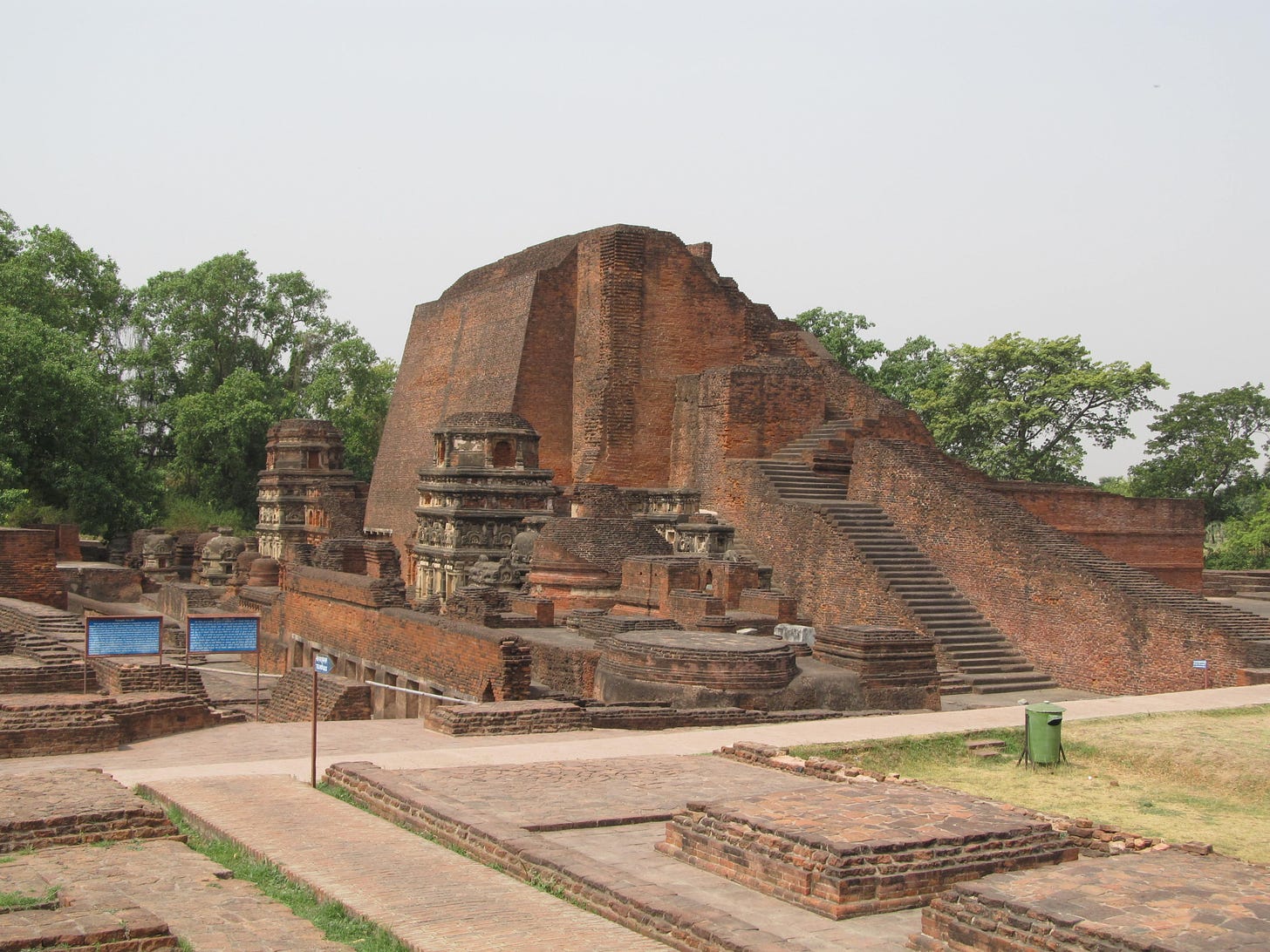Who Ended Nalanda?
A Critical Analysis of the Sources and Debates on the Fate of the Mahavihara
The destruction of Nalanda is among the most hotly contested topics in the subcontinent’s history. While the most debated ones like Aryan origins, beef in ancient India, and the antiquity of Sanskrit confine their jurisdictions to within the Indic ecosystem, this one represents a violent injection of a non-Indic one. The prevailing narrative, especially in Hindu nationalist circles, accuses a Turkic invader named Bakhtiyar Khilji. It posits the Delhi Sultanate’s eastern campaign that brought along a wave of repeated raids on the cities and monasteries of Bihar, Nalanda among them. This position, however, has been met with a serious challenge from the other side of the ideological spectrum that argues for a more indigenous, sectarian conflict as the cause of destruction. In this framework, Nalanda was a Buddhist stronghold envied and eventually destroyed by antagonistic Brahmins of the region. Both hypotheses enjoy widespread endorsement within their respective ideological confines which is what makes it a highly polarizing subject. Here, we’ll attempt to evaluate the substance in both scholarships and determine the winner on purely non-ideological grounds.
Before we get to its destruction, we must understand its inception. Not just for the sake of learning, but for the sake of the argument. How Nalanda was born, believe it or not, has a strong bearing on how it died and we’ll eventually see how. Contrary to what many believe, what we’re talking about here isn’t something all that ancient. While Taxila goes back to the fifth century BC, Nalanda only appeared in the fifth century AD which is when Taxila ultimately fell to the Huns and ceased to exist.
So our story starts in the first half of the fifth century when much of North India was under the Guptas. Today’s Bihar was then Magadha and formed the core of the Gupta polity. Pataliputra, today’s Patna, was its capital. On the throne was Kumaragupta I, son of the dynasty’s best-known name, Chandragupta. The Guptas were a Viaishnavite dynasty, a sharp departure from the prevailing Buddhist dominance in the region. The Mauryas, the Greeks, the Kushans—ever since Ashoka’s conversion, except for a few brief pockets of uncertainties, North India had remained under a largely Buddhist rule. The Guptas were the first major power that actively practiced and patronized a Vedic religion.
This, however, did not translate into any anti-Buddhist hostility, at least not as a state policy. By the time Kumaragupta took the throne, Taxila was already gone or at least in its death throes. Besides, it was impractical far from the Gupta capital in Pataliputra. So he decreed the establishment of a similar center of learning, equal in grandeur, not too far from the capital. This was to be a multidisciplinary residential institution with instructions in both Vedic and Buddhist studies. A site rich in lotus stalks or nāla, was chosen about fifty miles southeast of the capital and soon enough, the sangharama or monastery of Nalanda was born. Buddhist sources record Kumaragupta’s name as Shakraditya, likely an honorific. Two centuries later, the university would host the famous Chinese pilgrim Hsüen Tsang and find corroboration in his works. By then, the small monastery would’ve burgeoned into a full-blown mahavihara or university. Throughout this period, the university enjoyed more than generous monetary as well as material patronage from successive Gupta monarchs, something corroborated by seals, coins, and other epigraphical artifacts recovered from its ruins. Patronage also came from non-Gupta sources in the form of village grants and endowments. At its peak, the institution hosted students and teachers from as far away as Korea, Indonesia, Afghanistan, Persia, and even Turkey. Hsüen Tsang pegs the resident headcount at 10,000 students and 2,000 teachers which may have been an exaggeration. The number may have been closer to 3,000 as posited by another Chinese pilgrim, Yijing. These students studied both Buddhist as well as Vedic philosophies, both Pali as well as Sanskrit texts.1 We know this from the accounts of the famous Chinese pilgrim Xuanzang, who visited the university in the seventh century (more on him later).2
While the Guptas were inclusive in their religious outlook and patronized Buddhism with the same vigor as Vaishnavism, as Nalanda demonstrates, it must still be noted that this was a period of dramatic doctrinal shift. The Buddhists were losing political influence after centuries of dominance. Of course, there was an undeniable element of Brahmin-Buddhist animosity in the society. How this animosity expressed itself remains a matter of debate. We do know that in the middle of the sixth century a major spate of violence, particularly directed at Buddhists, swept through the region in the form of Mihirakula. His father was none other than Toramana who had destroyed Taxila earlier. Other than that, not much can be said with confidence about sectarian hostilities under the Guptas. What remains unimpeachable, however, is the enthusiastic Gupta patronage of Buddhist institutions despite their Vedic affiliations. And Nalanda is an important attestation to this fact, albeit it’s a misconception that the university curriculum was confined to Buddhism.

So this was the story of Nalanda’s birth and the circumstances of the time. Now that we understand the state of the society and the attitudes of the royalty surrounding Nalanda’s development, let’s finally get to its destruction. While mainstream scholarship still maintains Muslims as the perpetrators, Bakhtiyar Khilji in particular, there has been significant pushback to that position in recent years. In fact, the idea of non-Muslim perpetrators goes back centuries but now with the democratization of history, the position has gathered unprecedented steam. Therefore, we’ll first examine this position and then move on to the other, more mainstream one.
Keep reading with a 7-day free trial
Subscribe to Schandillia to keep reading this post and get 7 days of free access to the full post archives.




